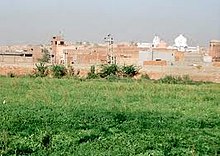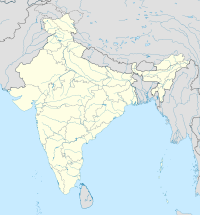
Rakhigarhi or Rakhi Garhi is a village and an archaeological site belonging to the Indus Valley civilisation in Hisar District of the northern Indian state of Haryana, situated about 150 km northwest of Delhi. It was part of the mature phase of the Indus Valley Civilisation, dating to 2600-1900 BCE. It was among the largest settlements of the ancient civilisation, though most of it remains unexcavated. The site is located in the Ghaggar River plain, some 27 km from the seasonal Ghaggar river. Initial excavations at the site happened in the 1960s, followed by further excavations in the late 1990s, however more sustained excavations have taken place in the past decade.

Charsadda District is a district in the Peshawar Division of the Khyber Pakhtunkhwa province of Pakistan. Prior to its establishment as a separate district in 1998, it was a tehsil within the Peshawar District. Pashtuns make up the majority of the population of the district. District headquarter is the town of Charsadda, which was once part of the Peshawar ex-metropolitan region.

Hisar also known as Hissar is the administrative headquarters of Hisar district in the state of Haryana in northwestern India. It is located 164 km (102 mi) to the west of New Delhi, India's capital, and has been identified as a counter-magnet city for the National Capital Region to develop as an alternative center of growth to Delhi.

Hisar district is one of the 22 districts of Haryana, India. Hisar city serves as the district headquarters. Hisar district has four sub-divisions that is, Hisar, Barwala, Hansi and Narnaud, each headed by an SDM. The district is also part of Hisar division. Hisar was founded by Firuz Shah Tughlaq.

Fatehabad district is one of the twenty two districts of the state of Haryana, India. Fatehabad was founded by Firuz Shah Tughlaq. Fatehabad district was carved out of Hisar district on 15 July 1997.
Agroha is a town in Haryana state of northern India. It is situated in Hisar district in between Hisar city and Fatehabad on NH 09. Ancient structures, pot-shards, coins and seals have been found in archaeological excavations at the Agroha Mound. The Agrawal and Agrahari communities claim origin from Agroha. According to their legends, Agroha was the capital of their founder Maharaj Agrasena.

Kaithal district is one of the 22 districts of Haryana, a state in northern India. Kaithal town is the district headquarters. The district occupies an area of 2317 km2. It has a population of 1,074,304. It is part of Karnal division. Kaithal was notified as district by Haryana Govt. on 16 October 1989 and carved out of Kurukshetra and Jind districts, comprising Guhla and Kaithal sub-divisions of Kurukshetra district, Kalayat sub-tahsil and 6 villages of Jind district.
Sanghol is a historical village located in Fatehgarh Sahib District of Punjab, India predating to Harrapan civilisation. It is also known as Uchha Pind Sanghol. It is about 40 km from Chandigarh on the way to Ludhiana and approximately 10 km from Dholewal. This place holds a special position on the archaeological atlas of India. Excavations at the site have yielded coins and seals related to Toramana and Mihirakula belonging to central Asia. A Buddhist stupa was excavated in 1968, but in February 1985 a rich treasure of 117 beautiful carved stone slabs, which includes 69 pillars, 35 crossbars, figures and figurines, was excavated by the experts of the Directorate of Archaeology, Punjab. Scholars have explained them as Kushan sculptures of the Mathura school of the 1st and 2nd centuries AD. These treasures have since been displayed for art lovers and historians in Sanghol Museum. Many of the art pieces from this museum often go on display as special exhibits at various museums around the world.

In religion and spirituality, a pilgrimage is a long journey or search of great moral significance. Sometimes, it is a journey to a sacred place or to a shrine of importance to a person's beliefs and faith. Members of every major religion participate in pilgrimages. A person who makes such a journey is called a pilgrim.
Lohari Ragho is a village and Indus Valley civilization archaeological site located in Hisar district of Haryana state in India. It has 3 separate mounds, each 1 to 1.5 km apart within the peripheral suburban zone of Rakhigarhi city cite, where artifacts belonging to Mature Harappan and Sothi-Siswal cultural period have been confirmed based on filed visits. These mounds, unprotected and under risk of encroachment and threat of obliteration, are yet to be excavated, fenced, protected or conserved.
Agroha is a Hindu temple complex in Agroha of Hisar District, Haryana, India. Construction started in 1976 and was completed in 1984. The temple is dedicated to the Hindu goddess Mahalakshmi.

Firoz Shah palace complex (Hisar-e-Firoza) is an archaeological complex located in modern-day Hisar, in the Haryana state of India, built by Firoz Shah Tughlaq of the Delhi Sultanate in 1354 AD. It is maintained by the Archaeological Survey of India.
Kunal is a pre-Harappan Indus Valley civilisation settlement located, just 30 km from Fatehabad City in Fatehabad district of Haryana state in India. Compared to other IVC sites, such as cities like Rakhigarhi and towns like Kalibangan, Kunal site was a village. Excavation at Kunal show 3 successive phases of Pre-Harappan indigenous culture on the Saraswati river who also traded with Kalibanga and Lothal. Kunal, along with its other contemporary sites Bhirrana and Rakhigarhi on Sarasvati-Ghaggar river system, is recognised as the oldest Pre-Harappan settlement, with Kunal being an older cultural ancestor to Rehman Dheri in Pakistan< which is on the Tentative List for future World Heritage Sites.
Bidhwan is a village and administrative unit with a democratically elected panchayat samiti in the Loharu, Siwani Tehsil of Bhiwani District under Bhiwani-Mahendragarh Lok Sabha constituency and Hisar Division of Haryana state.

Ancient idols of Jain Tirthankara were found in archaeological expeditions in Badli, Bhiwani, Dadri, Gurgaon, Hansi, Hisar (Agroha), Kasan, Nahad, Narnaul, Pehowa, Rewari, Rohad, Rohtak and Sonepat in Haryana. Agrawal Jain community traces its origins from Hisar. Guptisagar Dham Tirtha at Ganaur is a religious tourist spot in Haryana. It is named after the Jain Acharya Guptisagar.
Kalali is a village and administrative unit with a democratically elected panchayat samiti in the Loharu, Siwani Tehsil of Bhiwani District under Bhiwani-Mahendragarh Lok Sabha constituency and Hisar Division of Haryana state.

Srughna, also spelt Shrughna in Sanskrit, or Sughna, Sughana or Sugh in the spoken form, was an ancient city or kingdom of India frequently referred to in early and medieval texts. It was visited by Chinese traveller, Xuanzang in the 7th century and was reported to be in ruins even then although the foundations still remained. Xuanzang described the kingdom as extending from the mountains to the north, to the Ganges river to the East, and with the Yamuna river flowing through it. He described the capital city on the west bank of the Yamuna as possessing a large Buddhist vihara and a grand stupa dating to the time of the Mauryan emperor, Ashoka. Srughna is identified with the Sugh Ancient Mound located in the village of Amadalpur Dayalgarh, in the Yamunanagar district of Haryana state of India. To this day, the ancient Chaneti Buddhist Stupa, probably dating to the Mauryan period, stands in the area, about 3 kilometres (1.9 mi) northwest of Sugh.

Sugh Ancient Mound, also known as the Ancient Site of Sugh, is located in the village of Amadalpur Dayalgarh, in the Yamunanagar district of Haryana, India. Suryamandir-Tirth in Amadalpur is nearby. Buddhist stupa here is identified with the Srughna.
Badopal is a large village in Fatehabad tehsil of Fatehabad district of Haryana state in North India. Located on NH9, it is 14 km (8.7 mi) from Fatehabad, 13 km (8.1 mi) from Agroha, 36 km (22 mi) from Hisar, 200 km (120 mi) from national capital New Delhi and 207 km (129 mi) from state capital Chandigarh.















